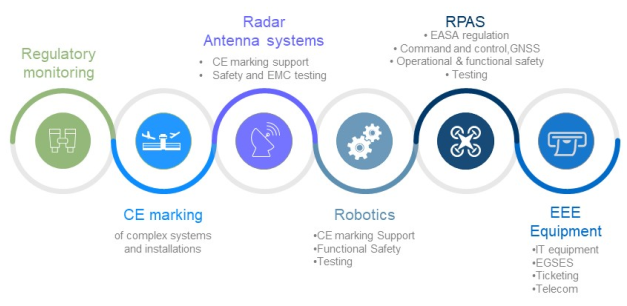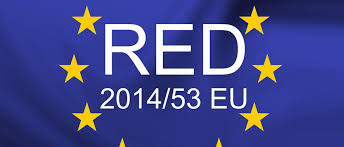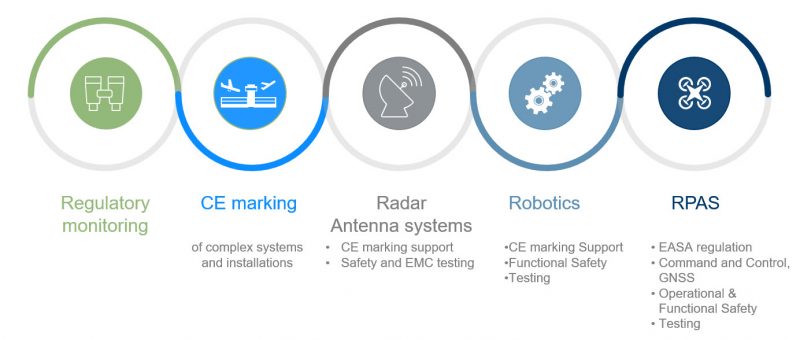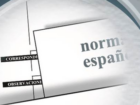CE Marking Directives

Regulations and standards to ensure safety and reliability
The CE marking of complex systems presents certain difficulties that require a solid expertise in order to achieve the objective without jeopardizing the time-to-market and increasing the cost of the solution. Complex systems are composed of several subsystems, result of the integration of products of different nature, type and origin, and subject to different directives. 
By stating the compliance of the product with the CE marking regulations, by means of the CE marking and the EC Declaration of Conformity, a manufacturer declares, on his sole responsibility, that the productmeets all the European legal requirements and that the conformity assessment procedure necessary to verify the conformity of the product to all the relevant essential requirements of the applicable directives has been carried out.
There are currently more than twenty CE marking directives, those most relevant to this type of systems are summarized here:
- machinery;
- interchangeable equipment;
- safety components;
- lifting accessories;
- chains, ropes and webbing;
- removable mechanical transmission devices;
- partly complete machinery.
The process to achieve CE marking for a complex system is depicted below. Compliance must be addressed from the very onset of the project so as to obtain CE marking in an easier and effective way.

NEW EMC AND LVD DIRECTIVES (CE MARKING)
The new directives that came into force on the 20th April 2016 are the following:
New EMC directive
Directive 2014/30/UE
– Electromagnetic compatibility of equipment (apparatus and fixed installation)
Directive 2004/108/CE is repealed from 20th April 2016
New LVD directive
Directive 2014/35/UE
– Market of electrical equipment designed for use within certain voltage limits
Directive 2006/95/CE is repealed from 20th April 2016
Most important changes:
- Alignement of EMC and LVD directives with the New Legislative Framework.
- The scopes of both directives don´t change except for the following exemption introduced in both directives:
- custom built evaluation kits destined for professionals to be used solely at research and development facilities
- As a consequence of the changes introduced in the RED directive, EMC and LVD directives will be applicable to telecom terminal equipment.
- Technical requirements practically don´t change. Conformity assessment procedures are adapted to NLF terminology.
- In general, more obligations for all economic operators (manufacturer, authorised representative, importer and distributor) are introduced, although the most important change is for the distributor, role not present before in the CE marking regulations.
- Measures to be taken by manufacturer, importer and distributor are stated in case of non-conforming products placed on the market.
- Products must be identified with type, batch or serial number to allow traceability. Also, manufacturers, and, where appropriate importers, shall indicate, on the apparatus, their name and the postal address.
What to do with already CE-marked products?
There is not transitional period:

-
- Products placed on the market PRIOR to 20th April 2016 must declare conformity with “old directives” 2004/108/CE and 2006/95/CE.
- Products placed on the market AFTER 20th April 2016 must declare conformity with “new directives” 2014/30/EU and2014/35/EU.
Consequently, declarations of conformity (DoC) of products placed on the market prior to 20th April 2016 shall be updated. Check that the declaration contains all the information required by the new directives. A model structure is included in annex IV.
Don´t forget you should continuously verify that the harmonized standard(s) used for the conformity assessment and listed in the DoC has (have) not been withdrawn. Otherwise it (they) will not provide presumption of conformity with the directive.
Check that the new traceability and identification requirements are met and that the equipment is accompanied by instructions in a language which can be easily understood by consumers.
| wdt_ID | Milestone | Date |
|---|---|---|
| 1 | New directive is applicable and R&TTE directive is repealed | On 13th June 2016 |
| 2 | New products must declare conformity with RED if placed on the market | After 13th June 2016 |
| 3 | Products that declared conformity with R&TTE before 13th June 2016 can be placed in the market. | Until 13th June 2017 |
NEW RADIO EQUIPMENT DIRECTIVE 
Radio Equipment Directive 2014/53/EU (RED)
- “Old” R&TTE directive is repealed by the “new“ 2014/53/EU directive (RED)
- RED is a CE marking directive that incorporates the New Legislative Framework (NLF) requirements.
- It applies ONLY to radio equipment, including radiodetermination equipment. Telecom terminal equipment that does not function using radio will be under the scope of EMC and LVD directives (where applicable). TV & radio receivers are now specifically included in the scope of the RED.
- In general, more obligations for all economic operators (manufacturer, authorised representative, importer and distributor) are introduced.
What to do with existing products?
Products assessed under the R&TTE directive before 13th June 2016 can be placed on the market until 13th June 2017.
After this date these products must declare conformity with the new RED directive unless not longer in the RED scope (e.g. telecom terminal equipment.).
An impact analysis has to be performed to identify which activities have to be carried out to comply with the new RED. Take into account that tests performed to assess conformity with R&TTE directive can be used in the conformity assessment of RED if the same harmonized standard continues providing presumption of conformity now with RED.
Check that the new traceability and identification requirements are met and that the equipment is accompanied by instructions in a language which can be easily understood by consumers.
Contact us for more information
- Quantum Key Distribution - 7th November 2022
- Conducted Immunity - 20th May 2019
- Electrical transients Test - 2nd May 2019





